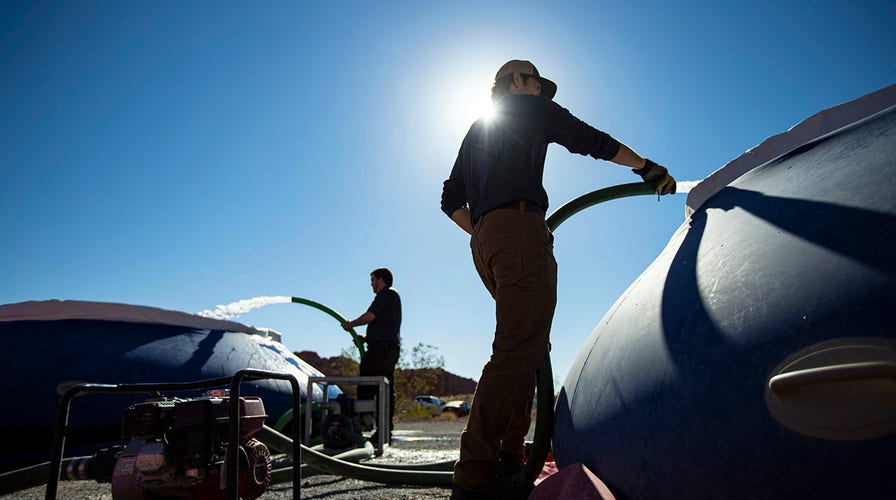Fox News Flash top headlines for June 26
Fox News Flash top headlines are here. Check out what's clicking on Foxnews.com.
More than 90% of the American West is in the grip of a historic and life-threatening drought – and summer 2021 is just beginning.
A map of the severe conditions released Thursday by the U.S. Drought Monitor – which was started in 2000 and is produced through a partnership of the University of Nebraska-Lincoln's National Drought Mitigation Center, the U.S. Department of Agriculture and National Oceanic and Atmospheric Administration – showed the vast region in dire straits.
PACIFIC NORTHWEST BAKES IN HISTORIC HEAT WAVE, WILDFIRE RISKS SOAR
NOAA's National Integrated Drought Information System (NIDIS) reported that for the third consecutive week, "extreme" and "exceptional" drought levels have set a record, with 49.7% of the West in that category.
"The high prior to the 2020/2021 drought was July 23, 2002, at 45.3%," the agency noted in a tweet.
More than 58 million people are impacted as the now more than two-decade-long drought worsens and multiple governors have declared states of emergency as temperatures and wildfire risk increase.
Intense, heat has plagued the West in recent weeks, baking already brittle vegetation, drying up worryingly empty reservoirs and smashing temperature records.
NOAA's climate page described drought and heat as "natural dance partners," with drought exacerbated when temperatures soar and vice versa.
A June 17 study published in the journal Nature Climate Change showed soil moisture has trended lower on the hottest days in the Southwest.
HISTORIC DROUGHT IN WEST BRINGS IN PLAGUE OF GRASSHOPPERS
Drought is also driven by La Niña conditions, which were in place through winter 2020 to 2021.
NOAA noted that there is evidence climate change has played a hand in creating this reality – with heat waves occurring more often and lasting longer since the 1960s and temperatures rising steadily due to the release of greenhouse gases.
Scientists warned last year that the worst-ever climate-spurred "megadroughts" could devastate the West, based on 1,200 years of tree ring data, modern weather observations and 31 advanced climate models.

Rick Thielmann, chief pilot at the Nevada Department of Wildlife, releases water using a "Bambi Bucket" at the "flipper" guzzler in the Muddy Mountains, in Clark County, Nev., Tuesday, June 8, 2021, during an emergency water haul operation. While the guzzlers are primarily utilized to assist the bighorn sheep population in the area, they also provide water for a variety of animals that populate the area. (Chase Stevens/Las Vegas Review-Journal via AP)
Going back more than a thousand years, there is evidence that naturally driven megadroughts have laid waste to the region several times -- often leading to social upheavals among indigenous civilizations.
Residents have been told to brace for impact and are advised to take precautionary measures this summer to help protect themselves from a myriad of worries.
Grasshoppers, which thrive in warm and arid weather have taken over and are beginning to denude trees.
A number of cities in Utah have banned fireworks ahead of the Fourth of July, worried about sparking devastating wildfires.
The Oregon Department of Fish and Wildlife is reportedly considering relocating some fish species to save them and doing away with bag limits for recreational anglers.
New Mexico parks officials have closed boat ramps throughout the state as reservoirs dry up.
Water supply is a common problem across the West, with 1,500 critical California reservoirs lower than half of what they should be this time of year and Idaho water managers cutting off irrigation flows to farmers. Thousands of farmers in the Golden State have been warned that they could face a similar fate.
CLICK HERE FOR THE FOX NEWS APP
Utah Gov. Spencer Cox urged residents and businesses to cut down on water usage, issuing multiple drought-related executive orders.
"We’re slowing down on our press conferences about the pandemic, and we’re headed right into another disaster," Cox told reporters earlier in June. "It’s been that kind of year for the state of Utah."
"The hots are getting a lot hotter in this state, the dries are getting a lot drier," California Gov. Gavin Newsom told the media in May. "We have a conveyance system, a water system, that was designed for a world that no longer exists."
The Associated Press contributed to this report.



